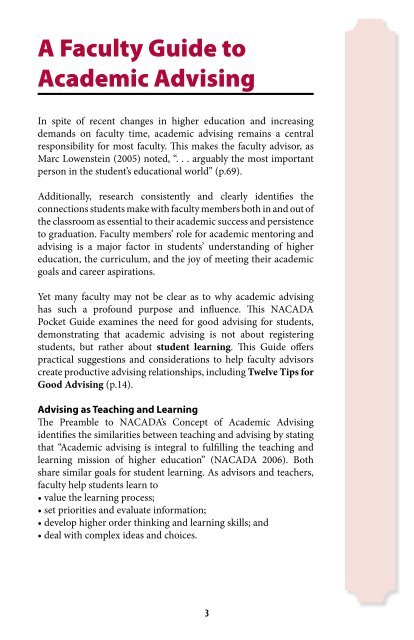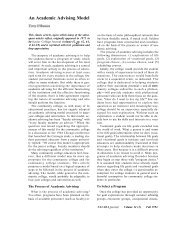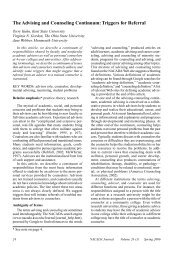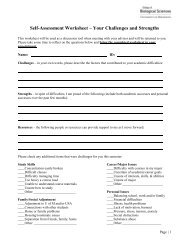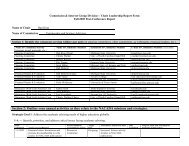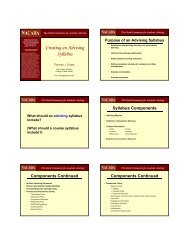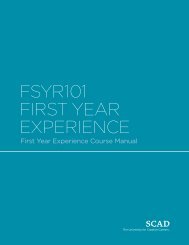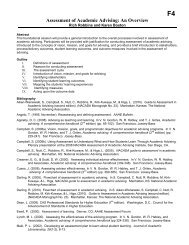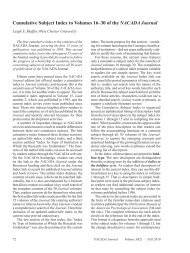A Faculty Guide to Academic Advising - NACADA
A Faculty Guide to Academic Advising - NACADA
A Faculty Guide to Academic Advising - NACADA
You also want an ePaper? Increase the reach of your titles
YUMPU automatically turns print PDFs into web optimized ePapers that Google loves.
A <strong>Faculty</strong> <strong>Guide</strong> <strong>to</strong><br />
<strong>Academic</strong> <strong>Advising</strong><br />
In spite of recent changes in higher education and increasing<br />
demands on faculty time, academic advising remains a central<br />
responsibility for most faculty. This makes the faculty advisor, as<br />
Marc Lowenstein (2005) noted, “. . . arguably the most important<br />
person in the student’s educational world” (p.69).<br />
Additionally, research consistently and clearly identifies the<br />
connections students make with faculty members both in and out of<br />
the classroom as essential <strong>to</strong> their academic success and persistence<br />
<strong>to</strong> graduation. <strong>Faculty</strong> members’ role for academic men<strong>to</strong>ring and<br />
advising is a major fac<strong>to</strong>r in students’ understanding of higher<br />
education, the curriculum, and the joy of meeting their academic<br />
goals and career aspirations.<br />
Yet many faculty may not be clear as <strong>to</strong> why academic advising<br />
has such a profound purpose and influence. This <strong>NACADA</strong><br />
Pocket <strong>Guide</strong> examines the need for good advising for students,<br />
demonstrating that academic advising is not about registering<br />
students, but rather about student learning. This <strong>Guide</strong> offers<br />
practical suggestions and considerations <strong>to</strong> help faculty advisors<br />
create productive advising relationships, including Twelve Tips for<br />
Good <strong>Advising</strong> (p.14).<br />
<strong>Advising</strong> as Teaching and Learning<br />
The Preamble <strong>to</strong> <strong>NACADA</strong>’s Concept of <strong>Academic</strong> <strong>Advising</strong><br />
identifies the similarities between teaching and advising by stating<br />
that “<strong>Academic</strong> advising is integral <strong>to</strong> fulfilling the teaching and<br />
learning mission of higher education” (<strong>NACADA</strong> 2006). Both<br />
share similar goals for student learning. As advisors and teachers,<br />
faculty help students learn <strong>to</strong><br />
• value the learning process;<br />
• set priorities and evaluate information;<br />
• develop higher order thinking and learning skills; and<br />
• deal with complex ideas and choices.<br />
3
As faculty advisors, we must have a clear sense of purpose about<br />
advising in the same way that we have a clear purpose when<br />
teaching a course. What do we want students <strong>to</strong> learn during<br />
advising discussions Or, in more familiar terms, what should be<br />
the “advising curriculum”<br />
Consider how an advising appointment offers the primary place<br />
in which students can reflect on the meaning of their educational<br />
programs. When unders<strong>to</strong>od in this way, the academic advising<br />
curriculum has the following goals. It<br />
• allows students time <strong>to</strong> think about the meaning of their course<br />
choices;<br />
• helps students make connections between what they are learning<br />
in and beyond the classroom; and<br />
• guides students in learning about the purpose and meaning of<br />
the academic curriculum as well as the academic mission of the<br />
institution.<br />
These curricular goals can be easily linked <strong>to</strong> specific student<br />
learning outcomes critical for student success. We should discuss<br />
with our advisees how advising might teach them <strong>to</strong><br />
• clarify personal values and educational goals;<br />
• guide their decision-making;<br />
• learn how <strong>to</strong> gather needed information systematically; and<br />
• reflect on their strengths and weaknesses and how these affect<br />
their academic plans.<br />
Identifying student learning outcomes for academic advising helps<br />
us focus our discussions with students. For example, advisees<br />
must learn certain types of information, e.g., campus rules and<br />
procedures that will help them build a reasonable schedule that<br />
meets requirements and also satisfies their intellectual interests. A<br />
further learning outcome might be <strong>to</strong> articulate the purpose of their<br />
choices and how these choices meet institutional expectations for<br />
their learning. Making these connections will demonstrate learning<br />
of higher order and reflective thinking skills (Martin 2007).<br />
4
Helping Students Learn<br />
Placing learning at the center of academic advising suggests that<br />
the faculty advisor should organize and create situations that help<br />
students meet specific learning goals. Research in education and<br />
psychology provides insights that can help guide our teaching<br />
strategies in the academic advising experience:<br />
• Students are active learners who draw on their current<br />
understandings and their social context <strong>to</strong> process what they are<br />
learning. This is called the “construction of knowledge.”<br />
• Effective learning strategies are based on knowledge of the<br />
individual learners.<br />
In other words, we should know our students. This type of<br />
information can be gleaned from the institutional environment and<br />
from advisee files, advising notes, transcripts, and our interactions<br />
with students. This general knowledge can provide a basis for<br />
identifying questions that might encourage critical and reflective<br />
thinking. This approach <strong>to</strong> advising involves<br />
• beginning a dialogue in which the advisor guides students;<br />
• teaching students <strong>to</strong> recognize and benefit from both their success<br />
and challenges;<br />
• asking questions that require students <strong>to</strong> think reflectively in<br />
order <strong>to</strong> respond; and<br />
• teaching students <strong>to</strong> express, justify and discuss individual goals<br />
and ideas.<br />
Approaching academic advising as an<br />
opportunity for student learning might<br />
sound like a tall order for already overworked<br />
faculty members. Understanding how we can<br />
integrate learning outcomes in<strong>to</strong> advising<br />
will help us direct students <strong>to</strong> achieve their<br />
academic goals. This Pocket <strong>Guide</strong> offers<br />
practical advice that makes it possible for any<br />
faculty member <strong>to</strong> become a great advisor.<br />
5
References and Resources<br />
Hemwall, M. and Trachte, K. (2005). <strong>Advising</strong> as learning: 10<br />
organizing principles. <strong>NACADA</strong> Journal 25(2), 74-83.<br />
Lowenstein, M. (2005). If advising is teaching, What do advisors<br />
teach <strong>NACADA</strong> Journal 25(2), 65-73.<br />
Martin, H. (2007). Constructing learning objectives for academic<br />
advising. Retrieved June 15, 2009, from <strong>NACADA</strong> Clearinghouse<br />
of <strong>Academic</strong> <strong>Advising</strong> Resources Web site: www.nacada.ksu.edu/<br />
Clearinghouse/<strong>Advising</strong>Issues/Learning-outcomes.htm.<br />
Reynolds, M. (2004). <strong>Faculty</strong> advising in a learner-centered<br />
environment: A small college perspective. <strong>Academic</strong> <strong>Advising</strong><br />
Today 27(2) 1-2.<br />
Practical Tools and Tips<br />
<strong>Academic</strong> advising offers the opportunity <strong>to</strong> engage students in<br />
learning. Yet how can faculty encourage learning during advising<br />
discussions that are typically not lengthy and may occur only<br />
intermittently If we are <strong>to</strong> help advisees develop critical thinking<br />
skills, value their educational experiences, and make important<br />
connections between their academic lives and career goals, then<br />
we must have specific information and <strong>to</strong>ols. Simple steps offer<br />
solutions.<br />
Using an <strong>Advising</strong> Syllabus<br />
Like the course syllabus used<br />
for a class, an advising syllabus<br />
introduces the purpose of advising<br />
and helps students understand<br />
the role of the advisor. It offers<br />
key information about the nature,<br />
responsibilities, and goals of the<br />
advising relationship. If we believe<br />
that students have a right <strong>to</strong> learn<br />
from us and that academic advising<br />
is more than just reviewing degree<br />
requirements and scheduling<br />
6
classes, then an advising syllabus becomes an effective <strong>to</strong>ol in<br />
providing essential information that otherwise must be repeated in<br />
numerous advising conversations.<br />
So that advisor/advisee expectations can be established right away,<br />
the syllabus is generally handed out either during orientation or at<br />
that first advising meeting, and should include<br />
• the advisor’s contact information, office location and office hours;<br />
• a calendar of important dates (e.g., last day <strong>to</strong> drop or withdraw<br />
from a course);<br />
• important campus resources (e.g., the on-line undergraduate<br />
bulletin, registrar, bursar, and financial aid office information);<br />
• an area for advisors <strong>to</strong> personalize the syllabus with any<br />
suggestions or recommendations for their students; and<br />
• the rights and responsibilities of both students and faculty in the<br />
advising/men<strong>to</strong>ring relationship.<br />
The syllabus should also clearly state advisors’ expectations for<br />
students, including that they<br />
• actively participate in the advising process;<br />
• come prepared <strong>to</strong> discuss problems and challenges; and<br />
• are responsible for their own actions.<br />
The syllabus should explain <strong>to</strong> advisees that advisors have<br />
responsibilities as well. These responsibilities may include that<br />
advisors<br />
• be punctual;<br />
• provide accurate information;<br />
• treat students with respect;<br />
• address students’ needs with confidentiality;<br />
• keep accurate records of contacts and student progress;<br />
• refer students <strong>to</strong> appropriate support services;<br />
• assist students in decision making;<br />
• allow students <strong>to</strong> make final decisions; and<br />
• maintain time limits for appointments.<br />
With expectations and responsibilities clearly delineated in a<br />
syllabus, advisors can more easily turn their attention <strong>to</strong> the primary<br />
purpose of the advising meeting, e.g., discussion of academic goals,<br />
career men<strong>to</strong>ring, course scheduling, or discussion of academic or<br />
personal matters.<br />
7


